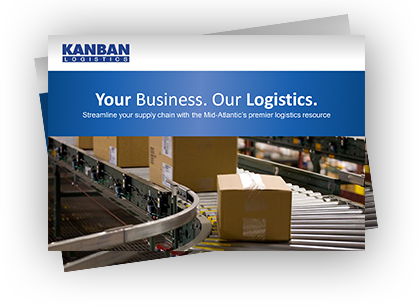As U.S. companies navigate the complexities of global trade, tariffs continue to squeeze margins, forcing many to re-evaluate how goods move through their supply chains. One of the most powerful tools in a cost-conscious shipper’s arsenal is intermodal transportation — the combination of rail and truck to optimize long-haul moves.
At Kanban Logistics, we’re more than ready to help you take advantage of intermodal savings. With direct access to the CSX Carolina Connector (CCX), our own rail siding, and a dedicated transload yard, we offer shippers a flexible, scalable alternative to full truckload (FTL) shipping — especially critical in a tariff-heavy economy.
Intermodal Shipping: A Smart Response to Rising Tariffs
- Cost Savings When You Need Them Most
Rail typically offers 10–30% savings over over-the-road (OTR) trucking, particularly for moves over 500 miles. With new tariffs on a wide range of imported goods (electronics, automotive parts, and more), every dollar counts — and intermodal helps protect your bottom line. - Fuel Efficiency = Lower Exposure to Volatility
Rail is up to four times more fuel efficient than trucking, according to the U.S. DOT Federal Railroad Administration. This translates into more stable pricing, even when fuel markets are volatile — a critical advantage for long-term freight planning. - A Hedge Against Unpredictable Surcharges
While tariffs increase the landed cost of goods, intermodal shipments can reduce inland costs, helping shippers reclaim some margin without sacrificing delivery timelines.
Freight Trends: Intermodal Volumes Are Up — For Now
Recent reports suggest that U.S. intermodal traffic is enjoying strong growth in 2025. According to FreightWaves:
- Total U.S. rail volumes are up 3.6% year-over-year, thanks in part to strong intermodal demand.
- Domestic container volumes grew 6.6% YOY in early 2025, with sectors like automotive and grain driving the increase.
- Intermodal strength is especially notable in the East Coast and Southeast, where infrastructure investments like the CSX Carolina Connector (CCX) have improved access and turnaround times.
Then Why the Forecast for Decline?
Interestingly, the same FreightWaves report warns that intermodal volumes may decline later in 2025 — in part due to tariffs. That may seem contradictory, but here’s why:
- Tariffs reduce overall import volume, as companies delay shipments or shift sourcing to domestic suppliers.
- Some shippers prefer the simplicity and flexibility of truckload during times of uncertainty.
- Companies that built up inventory earlier in the year (to beat new tariffs) may ship less product later, impacting container volumes.
So, while intermodal is still the cost-effective option, softer demand across the supply chain could lead to lower overall rail volumes, not because rail isn’t attractive, but because there’s less to move.
Kanban’s Intermodal Capabilities: Built for Flexibility
At Kanban Logistics, we’ve invested in the infrastructure and expertise to make intermodal work — especially for shippers navigating volatile economic conditions.
Strategic Location – Our 3PL operations in Rocky Mount, NC, put your freight just minutes from the CSX Carolina Connector (CCX) — a key East Coast intermodal hub connecting ports and major inland markets.
Direct Rail Siding – No added transfers, no delays. Our on-site rail siding means your containers roll in and out without ever leaving our property.
Transload Services – Our Mid-Atlantic transloading capabilities help importers maximize container usage, reduce dwell time, and transfer freight efficiently between modes.
Final-Mile & Regional Distribution – Need help beyond the rail yard? Our Eastern N.C. warehouse campus and regional trucking network serves the Southeast and Mid-Atlantic with dependable last-mile support.
Bottom Line: Don’t Let Tariffs Control Your Costs
Tariffs are likely here to stay — and they’re unpredictable. Your transportation strategy shouldn’t be.
Whether volumes are up or down, intermodal remains a reliable, cost-saving option — especially when you work with a partner who can handle every step, from rail siding to final delivery.
Ready to talk intermodal strategy? Contact Kanban Logistics to learn how we can help you lower costs and gain flexibility — no matter what the market brings next.
Never Miss a Blog Post
Join our email list to receive new posts in your inbox. We will never spam you. Opt out anytime.
Blog Post Categories
- Outsourcing 3PL (73)
- Warehousing (72)
- North Carolina (53)
- east coast logistics (47)
- manufacturing logistics (26)
- Food Logistics (19)
- Fulfillment (19)
- CSX Carolina Connector (18)
- Miscellaneous (14)
- FTZ / Free Trade Zones (12)
- Free Trade Zone (FTZ) (12)
- Intermodal (12)
- Rail Siding (12)
- Port of Virginia (11)
- Cross Docking (8)
- Kitting (5)
- Aerospace (3)
- Pharmaceutical (3)
- Kanban News (2)
- QVC Rework Services (2)
- container yard services (2)
- COO (1)
- flexible (1)
- iso certification (1)
- operations (1)
- scale (1)
- scott freeman (1)






